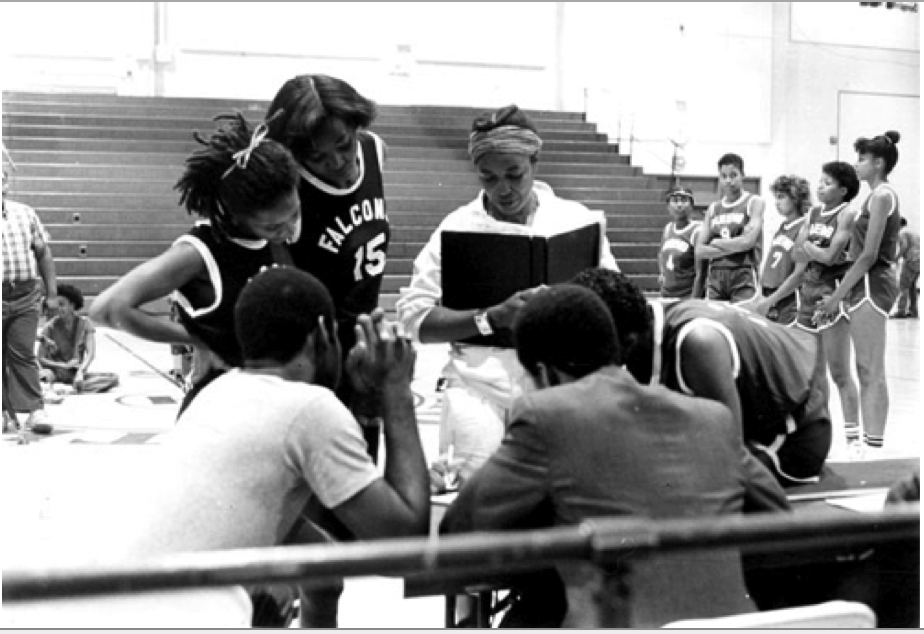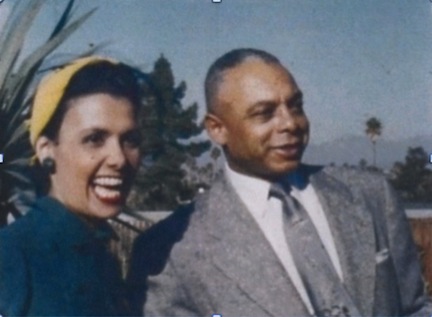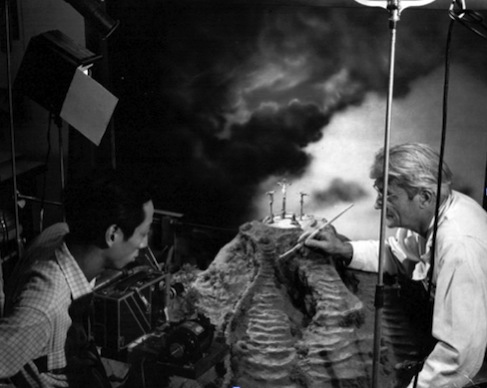Click here to print
Fifty-Seven Films Guaranteed Survival
posted June 4, 2015
The National Film Preservation Foundation has announced awards to 57 films. The grants guarantee that the 32 institutions in 21 states that hold the films will be able to repair and preserve them through the creation of new negatives, film prints, and digital access copies.

Jessie Maple on the set of Twice as Nice (1989).
The US Congress created the NFPF in 1996 as a charitable affiliate of the National Film Preservation Board of the Library of Congress. It has provided preservation support to 276 institutions and saved more than 2,223 films through grants and collaborative projects.
This year’s list is:
1944 Republican National Convention (1944), color footage of the convention and its delegates shot by amateur filmmaker Ellwood Hoffmann (Center for Home Movies).
Ambassadors in Levis: The Tucson Arizona Boys Chorus (ca. 1970), documentary ), about the Tucson Arizona Boys Chorus, produced by the University of Arizona (University of Arizona).
Beach Hike (1958), conservation film about a 3-day hike protesting a proposed coastal highway along the Olympic Peninsula (Oregon Historical Society).
Bon Temps Carnival Balls (1960–65), home movies of African American Mardi Gras carnival balls (Tulane University, Amistad Research Center).
Chemical Architecture (1968), film by Frank Mouris and Peter Schlaifer commissioned for the “Plastic as Plastic” show at the Museum of Contemporary Crafts in New York (Yale University). It is one of three student works by experimental animator Frank Mouris, whose Frank Film won the Oscar for Best Animated Short Film in 1974; the others granted NPFP funds this year (see below) are Quick Dream (1967) and You’re Not Real Pretty But You’re Mine (1968).
Cinema Metaphysique Nos.1-5 (1966–72), film-video hybrid works by Jud Yalkut and Nam June Paik, with music by Takehisa Kosugi (Anthology Film Archives). It is one among a group of films preserved this year that the late Yalkut made; he was a pioneer of fusing film and video technology – see, below, Clarence (1968), D.M.T. (1966), Electronic Fables (1971), Electronic Moon No. 2 (1967), Electronic Yoga (1966), and several others.
Clarence (1968), Jud Yalkut’s documentation of the seven-story house of outsider artist Clarence Schmidt (Anthology Film Archives).
Construction of the Seaboard Paper Company Mill (1930), professionally shot footage documenting the company’s factory in Bucksport, Maine (Northeast Historic Film).
Crow Indians on the Jesus Trail (ca. 1942–43), profile of the Crow Indian Mission in Lodge Grass, Montana (American Baptist Historical Society).
Czechoslovakia: Portrait of a Tragedy (1968), American-produced documentary film made during the Prague Spring featuring interviews with future president Vaclav Havel, economist Ota Sik, as well as ordinary citizens (Wende Museum).
D.M.T. (1966), psychedelic film by Jud Yalkut (Anthology Film Archives).
Dr. Eugenie Clark Laboratory Films (1946–65), research footage taken by the noted marine scientist (Mote Marine Laboratory and Aquarium).
Drifting (1923), new restoration of Todd Browning’s underworld saga about opium smuggling, featuring Anna May Wong in an early role (George Eastman House).
Electronic Fables (1971), film-video assemblage and audio collage by Jud Yalkut and Nam June Paik (Anthology Film Archives).
Electronic Moon No. 2 (1967), Jud Yalkut’s film of Nam June Paik’s video art (Anthology Film Archives).
Electronic Yoga (1966), film by Jud Yalkut and Nam June Paik (Anthology Film Archives).
Falnes Home Movies (1937–40s), travel films shot by NYU history professor and OSS analyst Oscar J. Falnes (New York University).
Frederick L. Anderson Collection (1942–45), footage shot by a U.S. Air Force major general including a holiday trip with Winston Churchill to Cuba (Hoover Institution, Stanford University).
From A to Z: The Story of Special Summer Schools (1964), sponsored film made by Goldsholl Design Associates for the Chicago Board of Education (Chicago Film Archives).

Lena Horne in one of three films from the Golden State Mutual Life Insurance Company Collection (1948–58) to be preserved by UCLA Library with support from the NFPF.
Golden State Mutual Life Insurance Company Collection (1948–58), footage of the largest — and for many years only — African American insurance company in the West, including a tour of its landmark office designed by Paul Revere Williams (UCLA Library). Golden State Mutual Life Insurance Company.
The Guest (1977), short psychological thriller by film scholar Pearl Bowser (National Museum of African American History and Culture, Smithsonian Institution).
Hank Rides Again (1963), tour of Arizona led by a Model-T Ford, produced by the Arizona Development Board (University of Arizona).
Hoover Kodacolor Home Movies (1928–30), films taken by Herbert Hoover’s family showing trips and White House activities (Herbert Hoover Presidential Library-Museum).
James Harvey Young World’s Fair Films (1933–34), footage of Chicago’s “A Century of Progress” exhibition (Emory University).
John Cage Mushroom Hunting in Stony Point (1972–73), the composer’s mycological pursuits, filmed by Jud Yalkut (Anthology Film Archives).
Kenyon Film (1972), Jud Yalkut’s diary film featuring poet Paul Blackburn and filmmaker George Landow (Anthology Film Archives).
Kip Taylor Loon Collection (1970s–80s), ecological documentation of Common Loons in New York’s Adirondack Park (Biodiversity Research Institute’s Adirondack Center for Loon Conservation).
Kusama’s Self Obliteration (1967), Jud Yalkut’s portrait of artist Yayoi Kusama (Anthology Film Archives).
Lewis J. Boss Collection, Part 2 (1929–32), community portraits of North Scituate, featuring hand-tinting and humorous intertitles, by a local amateur filmmaker (North Scituate Public Library).
Little Diomede (1960), documentary about the Inupiat of Little Diomede Island in the Bering Strait (Oregon Historical Society).
Lodge Grass Mission (ca. 1949), documentation of a church event at the Crow Indian Mission in Lodge Grass, Montana (American Baptist Historical Society).
Mambo (1951), Jordan Belson’s first surviving film, featuring mambo music and painted scrolls (Center for Visual Music).
Mandala (1953), Jordan Belson’s abstract depiction of Buddhist symbols (Center for Visual Music).
Metamedia: A Film Journal of Intermedia and the Avant-Garde (1966–73), Jud Yalkut’s footage of fellow experimental artists (Anthology Film Archives).
Metro!!!: A School Without Walls (1970), profile of a Chicago-based progressive experimental high school (Chicago Film Archives).
Mirror Eye (1992), Beryl Sokoloff’s abstract portrait of Times Square (Silver Bow Art).
Montana and its Aircraft (1968), sponsored film from the Montana Aeronautics Commission on the need to improve state airports (Montana Historical Society).
Montana and the Sky (1952), sponsored film from the Montana Aeronautics Commission on the daily use of aviation (Montana Historical Society).
More Than One Thing (1969), documentary profile of an African American teenager living in the Pruitt-Igoe housing complex of St. Louis (Washington University in St. Louis).
Navajo Film Themselves: Behind the Scenes (1966), Richard Chalfen’s footage of the project to teach filmmaking to Navajo residents of Pine Springs, Arizona (University of Pennsylvania Museum of Archaeology and Anthropology).
Orris Brown Collection (1940s–50s), footage related to Superior Film Studios, one of Houston’s first independent feature film companies (Texas Archive of the Moving Image).
P.A. (1983), Beryl Sokoloff’s kinetic exploration of New York City (Silver Bow Art).
Quick Dream (1967), first film by Academy Award winner Frank Mouris (Yale University).
Roof Piece (1973), avant-garde dance performance filmed by Babbette Mangolte (Trisha Brown Dance Company).
A Soil for Growth: A Story of the Gifted Child Program (ca. 1966), sponsored film made by Goldsholl Design Associates for the Chicago Board of Education (Chicago Film Archives).
Spain (1962), early 8mm work by Beryl Sokoloff capturing the lingering Old World traditions in Franco-era Spain (Silver Bow Art).
Twice as Nice (1989), feature film by Jessie Maple about twin-sister basketball stars competing for a single spot in the NBA draft (Black Film Center/Archive, Indiana University).
Videotape Study No. 3 (1966–69), Jud Yalkut and Nam June Paik’s filmed manipulation of political videos (Anthology Film Archives).

Wah Ming Chang and Blanding Sloan during the making of The Way of Peace (1947)
The Way of Peace (1947), an animated plea for pacifism written and directed by Frank Tashlin for the American Lutheran Church (UCLA Film & Television Archive).
We Live in the Arctic (1947), lecture film about the Alaskan adventures of Bud and Constance Helmericks (University of Alaska Fairbanks).
WSU Historic Films (ca. 1925–32), student activities, including athletic events and inter-class games (Wayne State University, Walter P. Reuther Library).
W.W. Howells Home Movies (1929), footage taken by the future Harvard anthropologist of the Santa Fe Fiesta and ancient ruins in northern New Mexico (New Mexico State Records Center and Archives).
You’re Not Real Pretty But You’re Mine (1968), early student film by Frank Mouris (Yale University).
The NPFP provided details about some of the awardees – you’ll be able to find features on some others here on Moving Image Archive News, in coming days.
Jessie Maple’s 1989 independent feature Twice as Nice, says the NPFP announcement, will be preserved by the Black Film Center/Archive at Indiana University. Maple took up filmmaking in the early 1970s, honing her craft at training schools and as an apprentice editor on two films by Gordon Parks. In 1975 she became the first African American woman member of IATSE, the International Alliance of Theatrical Stage Employees, Moving Picture Technicians, Artists and Allied Crafts of the United States, Its Territories and Canada, which since 1893 has represented workers in those trades.
With her husband, LeRoy Patton, Maple founded LJ Film Productions where they produced advocacy documentaries. Her first narrative film Will, made in 1981, was preserved by the Black Film Center/Archive in 2008.
Twice as Nice, which was Maple’s second fiction feature film “was the creation of many strong, talented women,” said Brian Graney, a film archivist who heads Public Technology Services at BFC/A, and who will supervise the project. “It tells the tale of basketball playing twin sisters in the days before the WNBA and uses real-life locations and nonprofessional actors to realize the screenplay by Saundra Pearl Sharp, the poet and actress who co-founded the Black Anti-Defamation Coalition,” said “We can’t wait to share it with new audiences.”
Another film awarded NPFP preservation funds this year is The Way of Peace (1947), which last year [2014] was placed on the National Film Registry. The UCLA Film & Television Archive will now preserve it with federal funding.
Long-time Warner Brothers animator Frank Tashlin directed the film before making the leap to live-action-feature filmmaking and notable films with Bob Hope, Jerry Lewis, and others.
The technical director of The Way of Peace was the Reverend H.K. Rasbach, who later advised Cecil B. DeMille on The Ten Commandments (1956) and George Stevens on The Greatest Story Ever Told (1965).
The special effects director who created the puppets used in The Way of Peace was the pioneering Wah Ming Chang, who later influenced generations of science-fiction films and television through his designs on Star Trek.
The awardee films also include home movies of the 1944 Republican National Convention, Winston Churchill in Cuba, and the Santa Fe Fiesta.
Printed from Moving Image Archive News: http://www.movingimagearchivenews.org
URL to article: http://www.movingimagearchivenews.org/fifty-seven-films-guaranteed-survival-with-federal-preservation-grants/
Click here to print